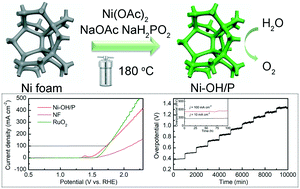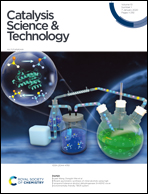Facile synthesis of self-supported amorphous phosphorus-doped Ni(OH)2 composite anodes for efficient water oxidation†
Abstract
Water oxidation plays a pivotal role in energy conversion and storage such as in water splitting and metal-air batteries. The development of a highly active and stable electrode for water oxidation at a low price is greatly challenging. Here, we report a self-supported oxygen evolution reaction (OER) electrode with a 3D porous Ni foam (NF) as a core and a dense layer of amorphous phosphorus-doped Ni hydroxide (Ni–OH/P) film as a shell. This facilely fabricated 3D core–shell structured electrode with directly grown active materials offered improved activity and prolonged stability for OER. It required an overpotential of 490 mV to deliver a current density of 100 mA cm−2; it showed a small Tafel slope at 87 mV dec−1 and sustained elongated electrolysis at 100 mA cm−2 for 100 h. The NiOOH shell was in situ formed on the surface of the Ni–OH/P film. Then, a new core–shell structured film was constructed. The synergetic effects of the newly formed crystalline NiOOH shell and amorphous Ni–OH/P core contributed to high stability under harsh conditions. This work presents a facile and easy scale-up path to develop self-supported hybrid electrodes for efficient and stable energy conversion and storage.



 Please wait while we load your content...
Please wait while we load your content...